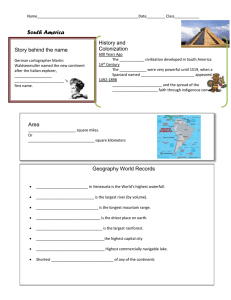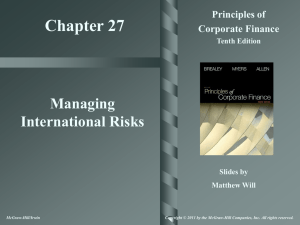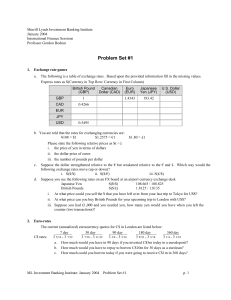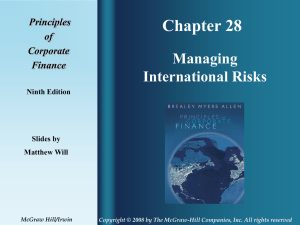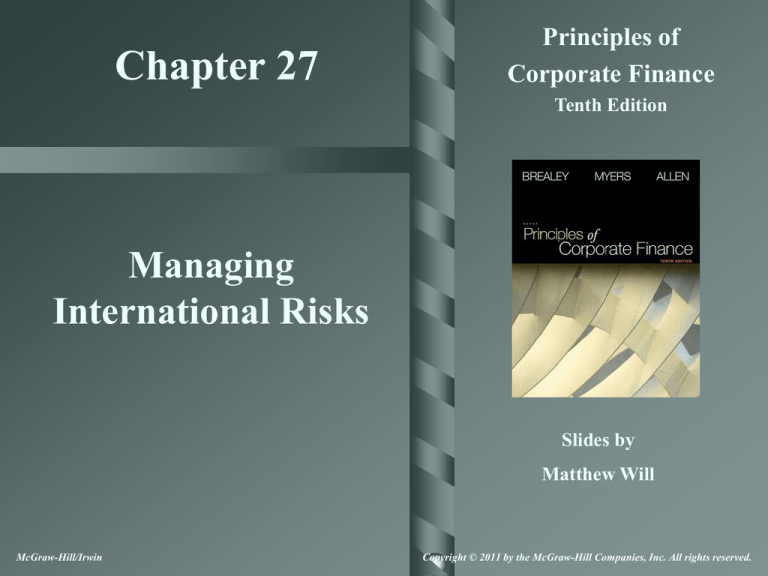
Chapter 27
Principles of
Corporate Finance
Tenth Edition
Managing
International Risks
Slides by
Matthew Will
McGraw-Hill/Irwin
Copyright © 2011 by the McGraw-Hill Companies, Inc. All rights reserved.
Topics Covered
The Foreign Exchange Market
Some Basic Relationships
Hedging Currency Risk
Exchange Risk and International Investment
Decisions
Political Risk
27-2
27-3
Exchange Rates
July 24, 2009
Forward Rate *
Spot Rate * 1 Month 3 Months 1 Year
Europe
EMU (euro)
Norway (krone)
Sweden (krona)
Switzerland (franc)
United Kingdom (pound)
Americas:
Canada (dollar)
Mexico (peso)
Pacific/ Africa:
Hong Kong (dollar)
Japan (yen)
South Africa (rand)
South Korea (won)
1.4201
6.2452
7.4533
1.0723
1.6414
1.4201
6.2502
7.4523
1.0719
1.6413
1.42
6.2603
7.4502
1.0711
1.6411
1.4207
6.3007
7.4313
1.0643
1.6396
1.0808
13.2155
1.0807
13.2705
1.0804
13.3805
1.0801
13.8891
7.7501
94.705
7.784
1249.55
7.748
94.678
7.833
1249.1
7.7437
94.6161
7.9263
1247.65
7.7311
94.087
8.3283
1241.05
Foreign Exchange Markets
Exchange Rate - Amount of one currency needed
to purchase one unit of another.
Spot Rate of Exchange - Exchange rate for an
immediate transaction.
Forward Exchange Rate - Exchange rate for a
forward transaction.
27-4
Foreign Exchange Markets
Forward Premiums and Forward Discounts
Example - The Peso spot price is 13.2155 peso per
dollar and the 3 month forward rate is 13.3805 Peso
per dollar, what is the premium and discount
relationship?
27-5
Foreign Exchange Markets
Forward Premiums and Forward Discounts
Example - The Peso spot price is 13.2155 peso per
dollar and the 3 month forward rate is 13.3805 Peso
per dollar, what is the premium and discount
relationship?
Spot Price
T
- 1 = Premium or (-Discount )
Forward Price
4
13.2155
- 1 = -1.20%
13.3805
27-6
Foreign Exchange Markets
Forward Premiums and Forward Discounts
Example - The Peso spot price is 13.2155 peso per dollar and
the 3 month forward rate is 13.3805 Peso per dollar, what
is the premium and discount relationship?
Answer - The dollar is selling at a 1.20% premium, relative
to the peso. The peso is selling at a 1.20% discount,
relative to the dollar.
27-7
Exchange Rates
Example
Swiss franc spot price is SF 1.0723 per $1
Swiss franc 1 yr forward price is SF 1.0643 per $1
The franc is selling at a Forward Premium
The Dollar is selling at a Forward Discount
This means that the market expects the dollar to get weaker,
relative to the franc
Example (premium? discount?)
The Japanese Yen spot price is 94.705 per $1
The Japanese 1 yr fwd price is 94.087 per $1
27-8
Exchange Rates
Example
What is the franc premium (annualized)?
Spot Price
T
- 1 = Premium or (-Discount )
Forward Price
1.0723
1
- 1 = 0.75%
1.0643
Example
What is the Yen discount (annualized)?
T
Spot Price
- 1 = Premium or (-Discount )
Forward Price
94.705
1
- 1 = 0.66%
94.087
27-9
Exchange Rate Relationships
Basic Relationships
1 + rforeign
1 + r$
1 + i foreign
equals
equals
equals
E(sforeign / $)
f foreign / $
S foreign / $
1 + i$
equals
S foreign / $
27-10
Exchange Rate Relationships
1) Interest Rate Parity Theory
1 + rforeign
1 + r$
=
f foreign / $
S foreign / $
The ratio between the risk free interest rates in two
different countries is equal to the ratio between the
forward and spot exchange rates.
27-11
Exchange Rate Relationships
Example - You have the opportunity to invest
$1,000,000 for one year. All other things being
equal, you have the opportunity to obtain a 1 year
Mexican bond (in peso) @ 6.67 % or a 1 year US
bond (in dollars) @ 1.505%. The spot rate is
13.2155 peso:$1 The 1 year forward rate is 13.8891
peso:$1
Which bond will you prefer and why?
Ignore transaction costs
27-12
Exchange Rate Relationships
27-13
Example - You have the opportunity to invest $1,000,000 for one year. All
other things being equal, you have the opportunity to obtain a 1 year Mexican
bond (in peso) @ 6.67 % or a 1 year US bond (in dollars) @ 1.505%. The
spot rate is 13.2155 peso:$1 The 1 year forward rate is 13.8891 peso:$1.
Which bond will you prefer and why? Ignore transaction costs
Value of US bond = $1,000,000 x 1.0150 = $1,015,000
Value of Mexican bond = $1,000,000 x 13.2155 = 13,215,500 peso exchange
13,215,500 peso x 1.0667 = 14,096,974 peso
bond pmt
14,096,974 peso / 13.8891= $1,014,967
exchange
Exchange Rate Relationships
2) Expectations Theory of Exchange Rates
f foreign / $
S foreign / $
=
E(sforeign / $)
S foreign / $
Theory that the expected spot exchange rate equals
the forward rate.
27-14
Exchange Rate Relationships
3) Purchasing Power Parity
1 + i foreign
1 + i$
=
E(sforeign / $)
S foreign / $
The expected change in the spot rate equals the
expected difference in inflation between the two
countries.
27-15
Exchange Rate Relationships
Example - If inflation in the US is forecasted at
1.0% this year and Mexico is forecasted at 6.0%,
what do we know about the expected spot rate?
Given a spot rate of 13.2155 peso:$1
1 + i foreign
1 + i$
=
E(sforeign/$)
S foreign/$
1 .060 E(sforeign/$ )
=
1 + .010
13.2155
solve for Es
Es = 13.87
27-16
Exchange Rate Relationships
4) International Fisher effect
1 + rforeign
1 + r$
=
1 + i foreign
1 + i$
The expected difference in inflation rates equals the
difference in current interest rates.
Also called common real interest rates
27-17
Exchange Rate Relationships
Example - The real interest rate in each country is
about the same
r (real )
1 + rforeign
1 + i foreign
1.0667
=
- 1 = .006
1.060
1 + r$ 1.015
r (real )
=
- 1 = .005
1 + i $ 1.010
27-18
Exchange Rates
Another Example
You are doing a project in Switzerland which has an initial cost of $100,000.
All other things being equal, you have the opportunity to obtain a 1 year
Swiss loan (in francs) @ 6.0% or a 1 year US loan (in dollars) @ 6.8%. The
spot rate is 1.0723 sf:$1 The 1 year forward rate is 1.0643 sf:$1
Which loan will you prefer and why? Ignore transaction costs
Cost of US loan = $100,000 x 1.068 = $106,800
Cost of Swiss Loan = $100,000 x 1.0723 = 107,230 sf
exchange
107,230 sf x 1.06 = 113,664 sf
loan pmt
113,664 sf / 1.0643 = $106,797
If the two loans created a different result, arbitrage exists!
exchange
27-19
Exchange Rates
% Forecast Error in Forward Rate for Swiss Francs
40.0%
30.0%
20.0%
10.0%
0.0%
-10.0%
-20.0%
-30.0%
-40.0%
-50.0%
Source: Global Financial Data
27-20
27-21
International Prices
The Big Mac Index – The price of a Big Mac in
different countries (July 16, 2009)
Country
Canada
China
Denmark
Euro area
Japan
Mexico
Local Price Converted
to U.S. Dollars
Country
Local Price Converted
to U.S. Dollars
3.35
1.83
5.53
4.62
3.46
2.39
Philippines
Russia
South Africa
Switzerland
United Kingdom
United States
2.05
2.04
2.17
5.98
3.69
3.57
27-22
Purchasing Power & Exchange Rates
25.00
Relative change in exchange rate, %
20.00
15.00
10.00
5.00
0.00
-5.00
-10.00
-15.00
Turkey
-25.00
USA
-20.00
-20.00
-15.00
-10.00
-5.00
-25.00
0.00
5.00
10.00
Relative change in purchasing power, %
15.00
20.00
25.00
Exchange Rates
Nominal versus Real Exchange Rates
U.S. Dollar /
UK (in log
scale)
27-23
Exchange Rates
Nominal versus Real Exchange Rates
U.S. Dollar /
France (in log
scale)
27-24
Exchange Rates
Nominal versus Real Exchange Rates
U.S. Dollar /
Italy (in log
scale)
27-25
Interest Rates and Inflation
Countries with the highest interest rates generally have the highest
inflation rates. In this diagram each of the 55 points represents a
different country.
Average money
market rate, %,
2000-08
40
35
30
25
Turkey
20
15
10
5
0
-5
Japan
-5
-10
0
5
10
15
20
Average inflation rate, %, 2000-08
25
30
27-26
Auto Industry Data 2003
Home Country
Europe
North America
Japan
Other
Panel A: Sales %
Ford
GM
Hyundai
Honda
Isuzu
Mazda
Mitsubishi
Nissan
Suzuki
Toyota
Fiat
BMW
DaimlerChrysler
Volkswagen
Peugeot
Renault
United States
United States
South Korea
Japan
Japan
Japan
Japan
Japan
Japan
Japan
Italy
Germany
Germany
Germany
France
France
30.30%
20.2
17.5
7.5
1.8
23.5
14.5
18.8
14.2
13.2
80.1
64.6
28.4
62.9
92.8
90.6
62.30%
67.6
31.1
54.8
14
34.6
22.8
40.2
4.5
32.8
0
30.6
68.4
13.4
0.5
0.8
0.00%
0
0
25.6
27.8
29.7
37.1
31.5
41.9
36.8
0
0
0
0
0
0
7.40%
12.2
51.4
12.1
56.4
12.2
25.7
9.5
39.4
17.2
19.8
4.9
3.2
23.7
6.7
8.6
Panel B: Production %
Ford
GM
Hyundai
Honda
Isuzu
Mazda
Mitsubishi
Nissan
Suzuki
Toyota
Fiat
BMW
DaimlerChrysler
Volkswagen
Peugeot
Renault
United States
United States
South Korea
Japan
Japan
Japan
Japan
Japan
Japan
Japan
Italy
Germany
Germany
Germany
France
France
35.20%
24.2
1.3
6.7
1
0
6
15.3
6.7
6.9
79.4
80.3
34.6
68.1
94.3
95.7
56.10%
64.5
0
43.2
7.2
16.9
10.7
27.8
0.5
18.8
0
14.8
63
5.8
0
0.8
0.00%
0
0
40.2
56.2
80.2
64.6
51.5
59.3
62.6
0
0
0
0
0
0
8.70%
11.3
98.7
9.9
35.6
2.9
18.6
5.4
33.5
11.6
20.6
4.9
2.4
26.1
5.7
3.6
27-27
Exchange Rate Risk
Example - Honda builds a new car in Japan for a cost +
profit of 1,715,000 yen. At an exchange rate of 94.705Y:$1
the car sells for $14,209 in Indianapolis. If the dollar rises
in value, against the yen, to an exchange rate of 134Y:$1,
what will be the price of the car?
1,715,000 = $18,109
94.705
Conversely, if the yen is trading at a
forward discount, Japan will
experience a decrease in purchasing
power.
27-28
Exchange Rate Risk
Example - Harley Davidson builds a motorcycle for a
cost plus profit of $12,000. At an exchange rate of
94.705Y:$1, the motorcycle sells for 1,136,460 yen in
Japan. If the dollar rises in value and the exchange rate is
103Y:$1, what will the motorcycle cost in Japan?
$12,000 x 103 = 1,236,000 yen
27-29
Exchange Rate Risk
Currency Risk can be reduced by using
various financial instruments
Currency forward contracts, futures
contracts, and even options on these
contracts are available to control the risk
27-30
Capital Budgeting
Techniques
1) Exchange to $ and analyze
2) Discount using foreign cash flows and
interest rates, then exchange to $.
3) Choose a currency standard ($) and
hedge all non dollar CF.
27-31
27-32
Example
Suppose that the Swiss pharmaceutical company, Roche, is evaluating
a proposal to build a new plant in the United States. To calculate the
project’s net present value, Roche forecasts the following dollar cash
flows from the project. The US cost of capital is 12% and the spot
exchange rate is 1.2sf / 1 $ . What is the project value in US dollars and
Swiss francs?
year
0
1
2
3
4
5
-1300
400
450
510
575
650
NPV ($) = $ 513 million
NPV (sf) = $513 x 1.2 (sf/$) = 616 sf million
27-33
Example
Suppose that the Swiss pharmaceutical company, Roche, is evaluating
a proposal to build a new plant in the United States. To calculate the
project’s net present value, Roche forecasts the following dollar cash
flows from the project. The US cost of capital is 12% and the spot
exchange rate is 1.2sf / 1 $ . What are the forward rates in each year, if
risk free rates are US = 6% and Swiss = 4%?
year
A:
0
1
2
3
4
5
-1300
400
450
510
575
650
(Ff/$) = ( 1 + rf )t solve for Ff/$
( 1 + r$ )t
Sf/$
year
Ff/$
0
1.2
1
2
3
4
5
1.177
1.155
1.133
1.112
1.091
27-34
Example
Suppose that the Swiss pharmaceutical company, Roche, is evaluating
a proposal to build a new plant in the United States. To calculate the
project’s net present value, Roche forecasts the following dollar cash
flows from the project. The US cost of capital is 12% and the spot
exchange rate is 1.2sf / 1 $ . What are the cash flows in each year,
given the forward rates?
year
0
1
2
3
4
5
-1300
400
450
510
575
650
1
2
3
4
5
A: CFf = (Ff/$) x CF$
year
0
CF$
-1300
400
450
510
575
650
Ff/$
1.2
1.177
1.155
1.133
1.112
1.091
CFf
-1560
471
520
578
639
709
Example
Suppose that the Swiss pharmaceutical company, Roche, is evaluating
a proposal to build a new plant in the United States. To calculate the
project’s net present value, Roche forecasts the following dollar cash
flows from the project. The US cost of capital is 12% and the spot
exchange rate is 1.2sf / 1 $ . What is the NPV of the project in Swiss
francs?
A:
1+ franc return = ( 1 + rf ) solve for Franc return
1+dollar return
Franc return = 9.9%
NPV (sf) = 616 sf
( 1 + r$ )
27-35
27-36
Political Risk
A
Maximium
12
Finland
9.5
Sweden
7.5
Switzerland
9.0
Australia
10.0
Germany
10.0
Singapore
11.0
United Kingdom 8.0
France
9.5
Japan
6.5
United States
6.0
China, Peoples' Rep.
11.0
Russian Federation.
11.5
Brazil
8.5
Turkey
9.0
India
6.0
Pakistan
4.0
Somalia
5.5
B
12
9.5
9.0
10.5
10.5
8.0
9.5
9.5
8.0
8.0
8.0
9.0
7.0
6.0
6.5
5.5
5.0
0.0
A = Govt stability
B = Socioeonmic conditions
C = Investment profile
D = Internal conflict
E = External conflict
F = Corruption
C
12
12.0
12.0
12.0
12.0
12.0
12.0
12.0
12.0
11.5
12.0
7.0
9.5
7.5
8.0
8.5
7.5
2.0
D
12
11.0
11.5
12.0
10.0
11.0
10.5
9.5
10.0
10.5
10.0
10.0
8.0
10.0
8.0
6.5
5.5
4.0
E
12
11.5
11.0
11.0
9.5
10.5
10.5
7.0
10.0
9.5
7.0
10.0
8.5
10.5
7.5
10.0
8.5
4.0
F
G
6
6.0
5.0
4.5
4.5
5.0
4.5
4.0
5.0
3.0
4.0
2.5
2.0
2.0
2.5
2.5
2.0
1.0
G = Military in politics
H = Religious tensions
I = Law and order
J = Ethnic tensions
K = Democratic accountability
L = Bureaucracy quality
H
6
6.0
5.5
6.0
6.0
6.0
5.0
6.0
5.5
5.0
4.0
3.0
4.5
4.0
2.0
4.0
1.0
1.0
I
6
6.0
6.0
4.5
6.0
5.0
4.5
6.0
4.0
5.5
5.5
5.0
5.5
6.0
4.5
2.5
1.0
3.0
J
6
6.0
6.0
5.0
5.5
5.0
5.0
5.5
5.0
5.0
5.0
4.5
4.0
2.0
4.5
4.0
3.0
0.5
K
6
6.0
5.0
4.0
4.0
4.0
6.0
4.0
2.5
5.5
5.0
4.5
3.0
3.0
2.5
2.5
1.0
2.0
as of January 2008
L
6
6.0
6.0
6.0
6.0
6.0
2.0
6.0
6.0
5.0
6.0
1.5
2.5
5.0
5.0
6.0
1.0
1.0
Total
4
4.0
4.0
4.0
4.0
4.0
4.0
4.0
3.0
4.0
4.0
2.0
1.0
2.0
2.0
3.0
2.0
0.0
100
93.5
88.5
88.5
88.0
86.5
84.5
81.5
80.5
79.0
76.5
70.0
67.0
66.5
62.0
61.0
41.5
24.0
Web Resources
Click to access web sites
Internet connection required
www.oecd.org
www.bankofengland.co.uk
www.ecb.int
www.oanda.com
www.x-rates.com
www.emgmkts.com
www.securities.com
www.prsgroup.com
27-37

